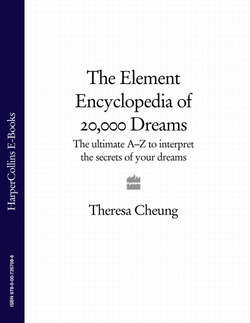Читать книгу The Element Encyclopedia of 20,000 Dreams: The Ultimate A–Z to Interpret the Secrets of Your Dreams - Theresa Cheung, Theresa Cheung - Страница 11
The Freud and Jung Revolution
Оглавление‘Dreams are often most profound when they seem the most crazy.’ Sigmund Freud
Austrian psychoanalyst Sigmund Freud (1858-1939) opened the door to the scientific study of dreams with his book, The Interpretation of Dreams (1900). In a relatively prudish age, he caused general outrage with his controversial theory that dreams are wish-fulfillment fantasies that have their origins in our infantile urges, in particular our sexual desires.
Freud believed that the human mind is made up of the id, the primitive or unconscious mind; the ego, the conscious mind which regulates the id’s antisocial instincts with a self-defense mechanism, and the superego, which is the consciousness that in turn supervises and modifies the ego. According to Freud, the id is controlled by the pleasure principle (the urge to gratify its needs) and the instinct that the ego finds hardest to manage is the sexual drive first awakened in childhood. The id comes to prominence in dreams, when it expresses in symbolic language the urges repressed when we are awake. Symbols are used, because if these drives were expressed literally, the ego would be shocked into waking up. To successfully interpret a dream the symbols need to be uncovered and their true meaning discovered. The way that Freud suggested doing this was a technique called ‘free association’ or spontaneously expressing the responses that immediately spring to mind when certain words relating to the dream are put forward. The aim is to limit interference from the ego to discover the dreamer’s unconscious instincts.
Swiss analytical psychologist Carl Gustav Jung (1875-1965), although an initial supporter of Freud’s ideas, could never fully agree with them. He felt there was far more to dreams than hidden sexual frustration and put forward the theory of the ‘collective unconscious’: a storehouse of inherited patterns of experiences and instincts common to humans and expressed in dreams in universal symbols, which he called ‘archetypes’. According to Jungian theory, the psyche is made up of the personal unconscious and the collective unconscious, and when a symbol appears in a dream, it is important to decide whether it relates to us personally or is an archetype. The way Jung suggested we do this is by a technique called ‘direct association’, i.e. concentrating only on the dream symbol when you think about the qualities associated with it.
Jung speculated that the unconscious mind projected dream symbols in an attempt to bring the conscious and unconscious mind into a state of balance he called ‘individuation’. According to his theory, the only way the unconscious mind can express itself fully is in dreams, so it will flood our dreams with symbolic messages that reflect our current progress in waking life. These messages can bring comfort and guidance, or bring repressed urges to the fore, but their aim is the same—to lead to our fulfillment. However, before we can benefit from such intuitive wisdom, we first of all need to understand the language of symbols.
